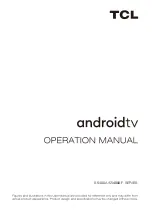
Electrical Alignments
8.
the DC-shift panel, cut diode 6433 for correction to the right
or diode 6432 for correction to the left.
Caution: Be sure to switch the set “off” first. Never plug in
a module that is not pre-aligned in a set that is 'ON'!
8.
* East West Parabola (EW. PARA). Aligns straight vertical
lines at the sides of the screen.
9.
* East West Upper Corner (EW. UCORN). Aligns straight
vertical lines in the upper corners of the screen.
10.
* East West Lower Corner (EW. LCORN). Aligns straight
vertical lines in the lower corners of the screen.
11.
East West Trapezium (EW. TRAP). Aligns straight vertical
lines in the middle of the screen.
12.
Horizontal Parallelogram (HOR. PARALLEL). Aligns
straight vertical lines at the top and the bottom, vertical
rotation around the center.
13.
Horizontal Bow (HOR. BOW). Aligns straight horizontal
lines at the top and the bottom, horizontal rotation around
the center.
14.
Vertical S-correction (VER. SCOR). Aligns for equal size
squares on the top, middle, and bottom of the picture tube.
Align so that the squares at the top (or bottom) of the
picture are the same height as the squares in the middle of
the picture.
Note: Also perform the alignments marked with a (*) in 480p
and 1080i mode.
Note: they are only available with a 2fH input signal on AV4:
1.
Use a 1080i pattern generator (for example Sencore
VP300). When you leave the geometry menu, the values
are stored.
2.
Use a crosshatch pattern, in which you can recognize a
vertical line which is placed on a horizontal amplitude of
about 87% (as seen from the center of the CRT). This line
is used as a reference to adjust the overscan situation in
1080i and 480p mode on the edge of the phosphor.
3.
Use the following offsets for V-ZOOM and V-SCROLL:
–
480p: V-ZOOM= 30 and V-SCROLL= 37.
–
1080i: V-ZOOM= 20 and V-SCROLL= 36.
Super Wide
Perform the same alignments described in the 'Geometry'
section.
4:3
You only need to align the following parameters (if the normal
geometry alignments have been performed correctly):
1.
East West Width (EW. WIDTH.) Aligns the picture width
until the complete test pattern is visible (similar to
Horizontal Amplitude).
2.
East West Upper Corner (EW. UCORN.) Aligns straight
vertical lines in the upper corners of the screen.
3.
East West Lower Corner (EW. LCORN.) Aligns straight
vertical lines in the lower corners of the screen.
8.4
Option Settings
The microprocessor communicates with a large number of I2C
ICs in the set. To ensure good communication and to make
digital diagnosis possible, the microprocessor has to know
which ICs to address. The presence / absence of these specific
ICs (or functions) is made known by the option codes. There
are two ways to do this:
•
Changing a single option.
•
Changing multiple options.
Notes:
•
Changes in the option settings are saved by leaving the
OPTION submenu.
•
The new option settings are only active after the TV is
switched 'off' and 'on' again (cold start) with the AC power
cord (the EAROM is then read again).
8.4.1
Changing a Single Option
Select the option with the MENU UP/DOWN keys, and change
its setting with the MENU LEFT/RIGHT keys.
8.4.2
Changing Multiple Options
Changing the option bytes directly makes it possible to set all
options very quickly. An option byte (OB1 - OB8) can be
selected with the MENU UP/DOWN keys and its setting can be
changed with the MENU LEFT/RIGHT keys. An option byte
represents a number of different options. All options of this
chassis are controlled via 8 option bytes. Select the option byte
(OB1 - OB8) and key in the new value with the number keys on
the remote control transmitter.
An option byte value is calculated in the following way:
Value 'option bit 1' x 1 =
Value 'option bit 2' x 2 =
Value 'option bit 3' x 4 =
Value 'option bit 4' x 8 =
Value 'option bit 5' x 16 =
Value 'option bit 6' x 32 =
Value 'option bit 7' x 64 =
Value 'option bit 8' x 128 =
========================
Total: value of 'option byte' =
When the NVM is replaced, all options will require resetting. To
be certain that the factory settings are reproduced exactly, you
must set both option number lines. You can find the correct
option numbers on the CRT sticker inside the TV set.
Example: The CRT sticker in the 30PW8520/17 gives the
following option numbers:
1.
252 255 189 245 (OB1 to OB4)
2.
128 000 000 000 (OB5 to OB8)
Summary of Contents for Chassis EM1.1A AA
Page 51: ...Circuit Diagrams and PWB Layouts 51 EM1 1A AA 7 Layout LSP Top Side ...
Page 53: ...Circuit Diagrams and PWB Layouts 53 EM1 1A AA 7 Layout LSP Overview Bottom Side ...
Page 54: ...54 EM1 1A AA 7 Circuit Diagrams and PWB Layouts Layout LSP Part 1 Bottom Side ...
Page 55: ...Circuit Diagrams and PWB Layouts 55 EM1 1A AA 7 Layout LSP Part 2 Bottom Side ...
Page 56: ...56 EM1 1A AA 7 Circuit Diagrams and PWB Layouts Layout LSP Part 3 Bottom Side ...
Page 57: ...Circuit Diagrams and PWB Layouts 57 EM1 1A AA 7 Layout LSP Part 4 Bottom Side ...
Page 126: ...Revision List EN 126 EM1 1A AA 11 11 Revision List First release ...
















































